RingCentral is recognized as a leading voice-over-internet-protocol (VoIP) provider, offering features like videoconferencing, team messaging, and advanced call analytics. While it’s a go-to solution for communication needs and reliability, it can be pricey. Alternatives with unlimited messaging or simpler phone systems may better suit smaller businesses or beginners. When considering an alternative, look for affordable, user-friendly options that scale with your needs.
Read our list of the seven best RingCentral alternatives to find the right fit for your company.
- Nextiva: Best for streamlined communications
- Talkroute: Best for messaging
- Zoom Phone: Best value for money
- Ooma: Best VoIP hardware
- GoTo Connect: Best global calling
- Phone.com: Best for fluctuating call volumes
- Grasshopper: Best for VoIP beginners
Best RingCentral Alternatives Compared
Alternatives to RingCentral | Monthly Starting Price | Key Features | FSB Rating (out of 5) |
|---|---|---|---|
$30 per user |
| 4.52 | |
 | $25 per user |
| 4.68 |
 | $19 (Single user) |
| 4.57 |
 | $10 per user |
| 4.54 |
 | $9.99 (Home Phone); $19.95 per user (Office) |
| 4.23 |
 | Custom pricing |
| 4.13 |
 | $14.99 per user |
| 4.01 |
 | $18 for one user |
| 3.91 |
Why You Can Trust Fit Small Business
Nextiva: Best for Streamlined Communications

What We Liked
- Provides a unified interface for team and customer interactions
- Allows unlimited participants in conference calls
- Comes with task management capabilities in team chat
How It Compares to RingCentral
- RingCentral and Nextiva offer up to 10,000 toll-free minutes, but Nextiva limits this to its top two plans, while RingCentral includes SMS credits with all plans.
- Unlike Nextiva, which offers unlimited SMS Short messaging service , RingCentral users get a maximum of 200 credits.
- Unlike RingCentral, Nextiva has its own VoIP hardware.
- Both providers offer a 99.999% uptime guarantee.
Our Expert Opinion
Nextiva emerges as the best alternative to RingCentral, offering a powerful blend of collaboration tools, VoIP functionality, and unified communication features, all seamlessly integrated into its NextivaONE and CoSpace apps. NextivaONE consolidates voice, video, messaging, and task management into a single platform, while CoSpace creates virtual workspaces for efficient communication and project collaboration.
With these tools, teams can manage client calls, share project updates, and coordinate campaign timelines without switching between applications. Nextiva’s VoIP features, such as auto-attendants, toll-free calling, and advanced call analytics, enable businesses to monitor performance and enhance customer service operations. Use threaded conversations to organize customer inquiries from different channels and understand the customer’s message history.
Similar to RingCentral, call forwarding, auto-attendant, and call recording are part of Nextiva’s phone system. However, with a digital option priced at $25 per user and its basic phone system starting at $36 per user, it can be pricey for solopreneurs and micro or home-based teams. If affordability is your priority, Zoom Phone is still the best choice with a $10-per-user base-tier plan.
Plan Price (Per User)* | Digital | Core | Engage | Power Suite |
|---|---|---|---|---|
Monthly | $25 | $36 | $50 | $75 |
Annually | $20 | $30 | $40 | $60 |
*Pricing is based on one user. Nextiva offers a free demo for those interested in exploring the platform. | ||||
- Digital: Competitive monitoring, messaging applications, unified digital user inbox, 24/7 support, geo-redundancy, review management, and digital service helpdesk
- Core: Inbound and outbound voice, smart call routing or IVR, 100 SMS credits, voicemail with AI transcription, desktop and mobile apps, call routing, screen and file sharing, unlimited business voice and video meeting and conferencing, and team chat
- Engage: Live chat, chatbot, 250 SMS, digital fax, toll-free number and 2,000 minutes, advanced reporting, MS Teams integrations, inbound sales and service call center, and voice call recording
- Power Suite: Unlimited SMS, 10,000 toll-free minutes, intelligent routing, per-use advanced IVR, supervisor dashboard, and unlimited reporting
- NextivaONE app: The platform offers a unified desktop experience, combining all interactions across all channels into a single view. With customer experience and productivity tools, you can access all conversations (phone, SMS, video, and email).
- Call presence: Nextiva displays other users’ phone availability, whether online, busy, away, or offline. Users can add a message below their status.
- Notes on calls: You can add notes while on a call without switching screens. The note is automatically saved with the contact record.
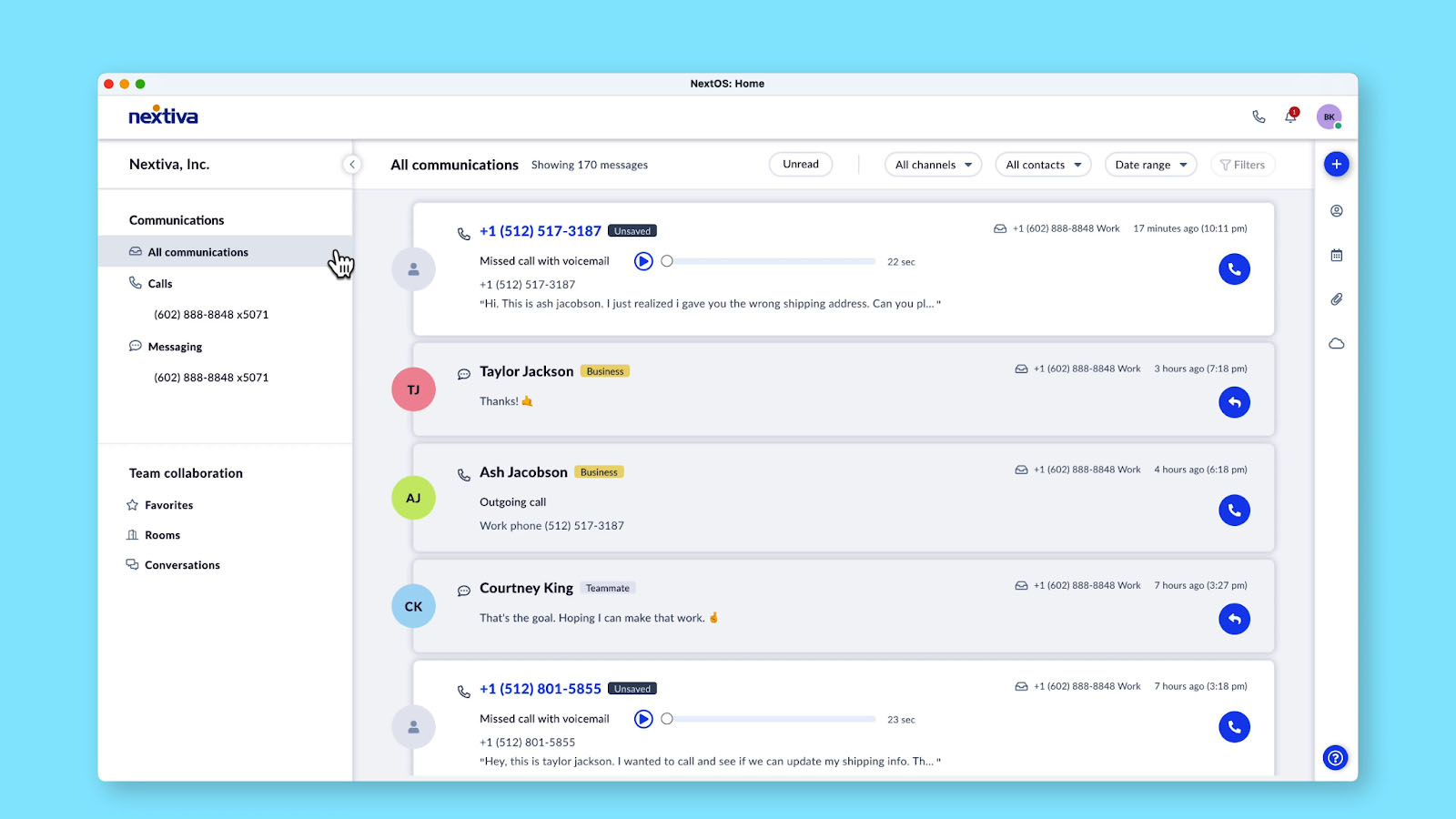
Manage customer communications in various channels on NextivaONE. (Source: Nextiva)
Talkroute: Best for Messaging

What We Liked
- Includes single and multidigit extensions
- Provides local number registration and campaign fee services
- Offers professional voiceover services with the Voice Studio
Where It Falls Behind
- Lacks the auto-attendant feature in the base tier
- Comes with limited integrations, except Zapier
- Unlocks file and screen sharing in higher tiers
How It Compares to RingCentral
- RingCentral supports over 300 integrations, whereas Talkroute is limited to Zapier.
- RingCentral guarantees 99.5% uptime for all plans, while Talkroute’s higher 99.98% SLA Service level agreement is restricted to its top-tier plan.
- Unlike Talkroute’s unlimited messaging, RingCentral only offers 25 to 200 SMS credits monthly
Our Expert Opinion
Talkroute is the leading alternative to RingCentral, with more messaging communications features. It offers both metered and unlimited texting options. Its ability to register toll-free and local numbers for campaigns lets companies streamline communication across channels and strengthen brand image. The base plan includes 500 text credits, and higher plans offer unlimited texting, which is great for staying in touch with clients and team members without message limits.
For example, a campaign marketing team can manage SMS and phone calls through Talkroute’s all-in-one platform. VoIP features support smaller teams by providing key tools like call forwarding, voicemail-to-email, and customizable greetings. These tools help businesses stay organized and responsive to customer needs.
While Talkroute offers substantial value, its app is more intuitive and user-friendly, making it ideal for businesses with more straightforward communication needs. If you’re always on the go and require a powerful app with complete functionality, Nextiva is a great option. Nextiva excels with its feature-rich VoIP and collaboration and wide range of tools for comprehensive communication tools, though it may require a steeper learning curve.
Plan Price* | Basic | Plus | Pro | Enterprise |
|---|---|---|---|---|
Monthly | $19 | $39 | $59 | Custom pricing |
*Additional users cost $5 a month. | ||||
- Basic: One user, 500 text messages, one local and toll-free number, call forwarding, call stacking, and custom greetings
- Plus: Three users, two numbers, unlimited text messages, live transfer, auto-attendant, single-digit extensions, and simultaneous ring
- Pro: 10 users, three numbers, 10 voice mailboxes, IVR submenus, multilevel auto-attendant, unlimited multidigit extensions, scheduled call forwarding, call recording, and analytics
- Enterprise: Custom pricing for more than 20 users, SLA, and dedicated account manager
- Free trial: Seven days
- Local number registration: Talkroute allows businesses to register local numbers and enhance their local presence. This builds trust with regional customers and establishes credibility.
- Video whiteboard: Use Talkroute’s video whiteboard feature to collaborate visually. It’s useful for real-time group brainstorming and idea sharing during virtual meetings.
- Custom greeting: Create personalized greetings with Talkroute to deliver a professional, branded experience for callers. Use the Voice Studio for high-quality voice recordings for phone greetings, menus, and announcements.
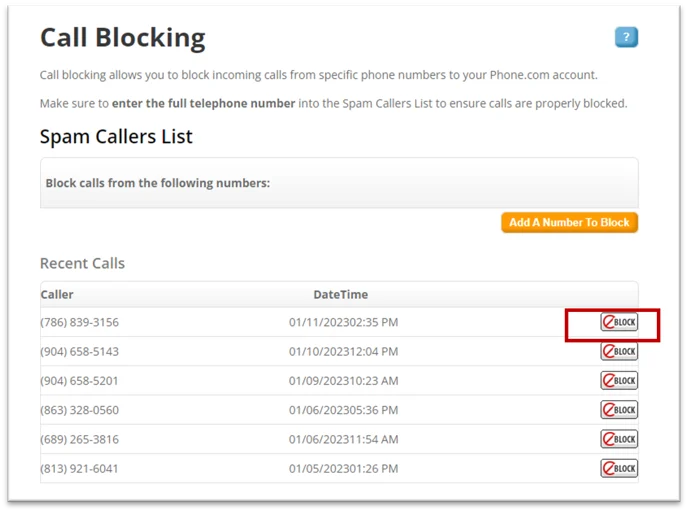
Use professional greetings by uploading or recording an audio file. (Source: Talkroute)
Zoom Phone: Best Value for Money

What We Liked
- Features advanced VoIP tools like call monitoring and call delegation in the base plan
- Provides an easy-to-use interface
- Integrates with over a hundred third-party apps
Where It Falls Behind
- Requires an extra fee for queue analytics
- Lacks unlimited texting
- Provides limited reporting capabilities
How It Compares to RingCentral
- Zoom Phone’s entry-level plan costs $10 per user, while RingCentral starts at $30 per user monthly.
- Zoom Phone offers unlimited regional calling in 48 countries and territories, while RingCentral limits it to 1,000 minutes per user.
- Zoom supports up to 1,000 video participants, compared with RingCentral’s 200-person capacity, and there is an add-on fee requirement for a webinar setup
- RingCentral retains cloud recordings for one year, while Zoom offers specific retention periods.
Our Expert Opinion
Zoom Phone is a cheaper alternative to RingCentral because it offers a pay-as-you-go plan, starting at just $10 per user per month, and seamless integration with Zoom’s popular videoconferencing and chat platform. Combining a reliable phone system with video and messaging capabilities, Zoom Phone delivers a unified communication (UC) experience, allowing users to transition effortlessly between calls, meetings, and chats.
A customer support team can manage calls, escalate issues to video meetings, and track resolutions in team chat within Zoom Phone. Key VoIP features include call routing to reduce wait times and call recording with analytics to enhance performance. Users can seamlessly switch between calls, chats, and video meetings, streamlining workflows without external apps.
Zoom Phone delivers substantial value with a local direct-dial number and unlimited domestic calling per license. Users can add toll-free, local, or international premium numbers, starting at $5 monthly.
Alternatively, Grasshopper is our recommended best virtual phone number provider, offering multiple numbers per account based on your plan. Its highest tier includes four numbers and unlimited extensions, perfect for growing businesses looking to manage costs.
Plan Price (Per User) | US & Canada Metered | Regional Unlimited | Global Select |
|---|---|---|---|
Monthly | $10 | $15 | $20 |
- US & Canada Metered: Metered domestic calling within the US and Canada and a local number
- US & Canada Unlimited: Unlimited domestic calling and optional add-on for unlimited calling to 19 countries
- Global Select: Unlimited regional calling in one of the 48 territories supported and the optional add-on of unlimited calls to 19 countries
- Call park: Move an active call to a communal “parking spot” where colleagues can pick it up from their extension. This is beneficial when you want other, more skilled agents to take the customer’s inquiry or when you need to attend to other urgent matters.
- Shared line: Choose a delegate to answer calls on behalf of a user. Set up a shared line group to ensure multiple users and devices can accommodate incoming calls.
- Call takeover: Listen to ongoing customer conversations and join the call if you need to address the customer directly. This call monitoring tool removes the agent from the phone call.
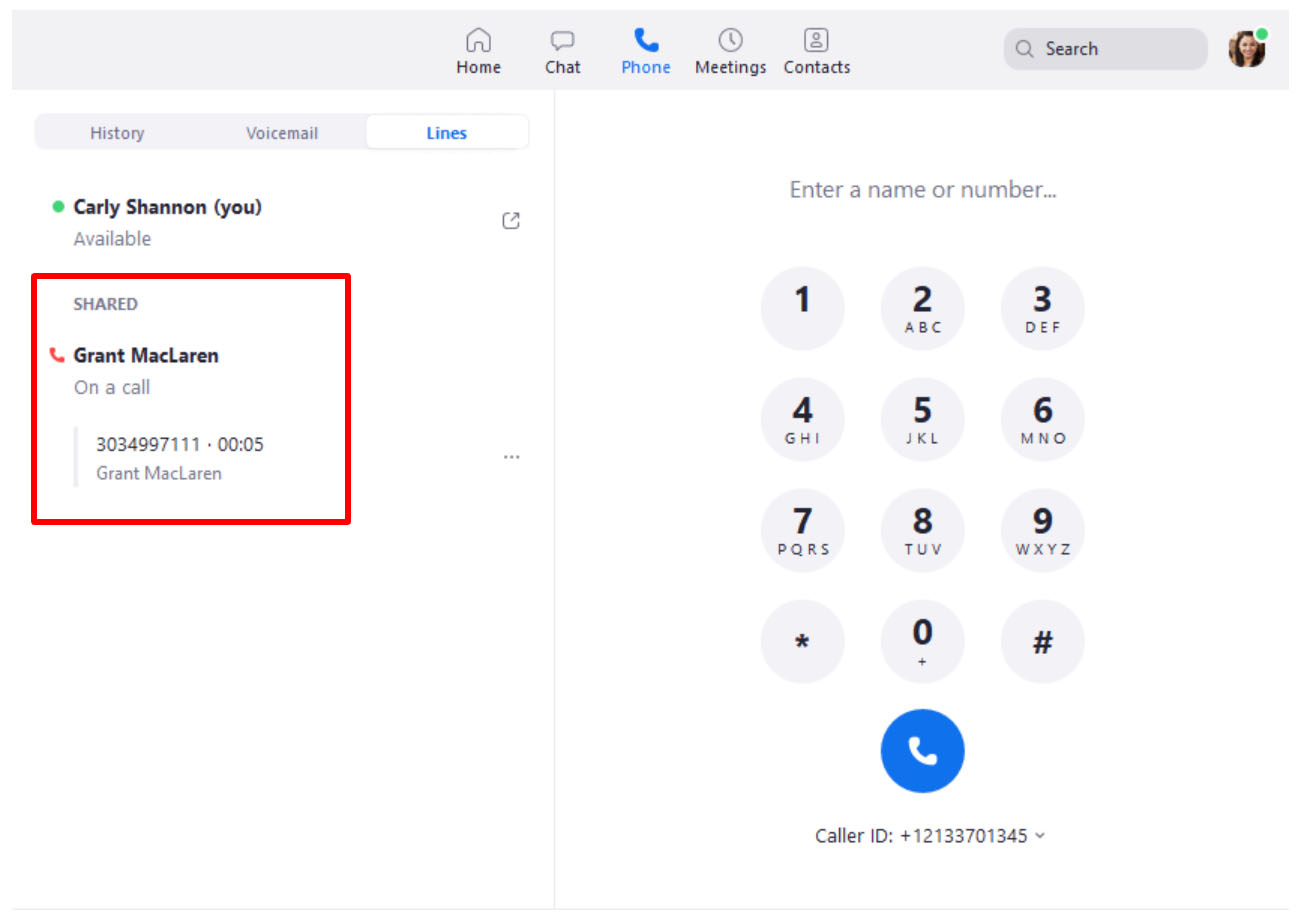
Set up shared lines on Zoom Phone to let other users take incoming calls on your behalf. (Source: Zoom)
Ooma: Best VoIP Hardware

What We Liked
- Includes 50-plus standard phone features
- Offers 500 toll-free minutes per month with all office plans
- Comes with local, toll-free, and vanity numbers
Where It Falls Behind
- Comes with limited app integrations
- Allows a maximum video meeting participant capacity of 100
- Lacks a desktop app on the base plan
How It Compares to RingCentral
- RingCentral offers unlimited calling in the US and Canada. Ooma extends this feature to Mexico and Puerto Rico only.
- Unlike RingCentral’s UCaaS platform, Ooma offers an autodialer, which streamlines customer outreach efforts.
- Ooma offers a residential plan that doesn’t have monthly charges. RingCentral doesn’t have a free plan.
- Both providers support intercom paging.
Our Expert Opinion
Ooma is the best among RingCentral competitors if you want to complement VoIP software solutions with hardware phones. It offers first-party hardware and devices from other reliable brands. Its hardware includes IP and Wi-Fi phones, which accommodate different call volumes. It has its own analog telephone adapter (ATA), Ooma Telo, enabling landline systems to place and receive calls online. Ooma also offers Yealink and Grandstream phones.
Like RingCentral, hot desking is a feature available on Ooma. Users can sign into different devices in their system and access their unique profile settings. The provider offers year-round discounts for phones for sale, making it equally competitive with RingCentral’s promotion codes.
Unfortunately, when you compare Ooma vs RingCentral in terms of interface, RingCentral has a more intuitive, modern look. Some of the alternatives in this buyer’s guide also have a neat, sleek appearance. Our first two picks, Zoom Phone and Nextiva, are great options. User-friendly interfaces help small businesses save time, reduce the learning curve, and focus on growth over troubleshooting.
Plan Price (Per User)* | Essentials | Pro | Pro Plus |
|---|---|---|---|
Monthly | $19.95 | $24.95 | $29.95 |
*Ooma charges a $49.95 activation fee and a $99.99 hardware cost for Telo Basic and Premier plans. All office plans include 50-plus features like unlimited calling and virtual receptionist services. | |||
Home Phone Plans
- Basic: Free for US and Canada calling, call waiting, call logs, voicemail, and call blocking
- Premier: $9.99 for enhanced caller ID, custom call blocking, advanced voicemail, call forwarding, and multiring
Office Plans
- Essentials: One toll-free number, ring groups, call blocking, virtual receptionist, and overhead paging support
- Pro: Text messaging, call recording, call analytics, voicemail transcription, and up to 25 video meeting attendees
- Pro Plus: Call queues, call screening, team chat, hot desking, CRM integrations, and up to 100 video meeting attendees
- Find me, follow me: Create rules for receiving incoming calls in specific locations and which devices will ring. Forward calls to specific devices and ring them at once or in a particular order.
- Digital call deflection: Allow customers to shift the conversation from voice call to text message. This is useful for reducing customer wait times.
- Auto dialer: Ooma automatically dials phone numbers in a contact list uploaded from a comma-separated-values (CSV) file. This speeds up customer outreach and reduces agents’ manual work.
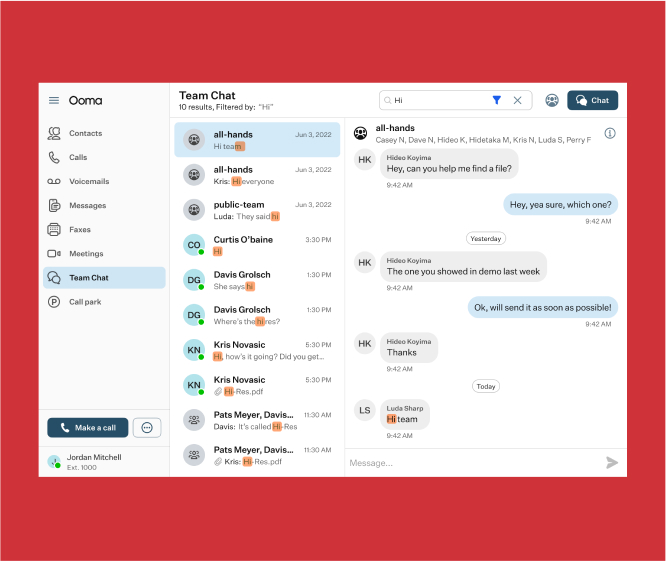
Ooma’s team chat enables real-time collaboration for better communication and productivity. (Source: Ooma)
GoTo Connect: Best for Global Calling

What We Liked
- Scales easily from a phone system to a contact center
- Includes an intuitive phone tree configuration tool
- Gives all users access to unlimited ring groups
Where It Falls Behind
- Lacks international number support
- Doesn’t include AI capabilities in its phone system
- Website lacks readily available pricing details
How It Compares to RingCentral
- GoTo Connect offers 1,000 shared minutes across all accounts, while RingCentral offers 100 to 10,000, depending on the plan
- Both solutions have team messaging with file-sharing
- RingCentral offers more robust AI features than GoTo Connect and includes them in all its plans.
Our Expert Opinion
GoTo Connect is perfect for growing businesses with international needs. It offers unlimited domestic and international calling to over 50 countries and 1,000 shared toll-free minutes—streamlining global communications and reducing the need for separate services. For example, a multinational company can connect offices worldwide without worrying about high international call charges.
Unlimited international calling allows you to call contacts in over 50 countries for free, including Australia, China, France, Germany, Italy, and the United Kingdom. Establish and maintain a strong rapport with overseas partners and clients.
Although it features excellent international calling capabilities, one potential shortcoming of GoTo Connect is that it caps its toll-free minutes at 1,000 free minutes shared across accounts. If you need more toll-free minutes, Nextiva is a better match. Like RingCentral, Nextiva offers a maximum of 10,000 toll-free minutes. Choose Nextiva if you want a VoIP phone system with UC capabilities, including a generous toll-free calling allowance.
Plan Price (Per User) | Phone System | Connect CX | Contact Center |
|---|---|---|---|
Monthly | $29 | $34 | $86 |
Annually | $26 | $37 | $80 |
- Phone System: 1,000 toll-free minutes, unlimited global calling, smart call routing, call queues, call handling, team chat, and video meetings
- Customer Engagement: Shared inbox, virtual assistant, surveys, SMS/MMS campaigns, and custom analytics dashboards
- Complete CX: Advanced call routing, skills management, agent monitoring, supervisor analytics, and queue callback
- Contact Center: Screen recording, quality management, auto dialer, and workforce management integrations
- Free trial: 14 days
- Instant response: Automatically respond to each missed call from first-time callers or new customers using a custom message. This message can state the date and time you’re free to take a call or provide alternative ways to reach you.
- Three-way calling: Have quick huddles with team members or clients to discuss urgent matters. To use this feature, you’ll need to be in an active call, add another participant, and merge multiple calls.
- Customizable dial plans: Use an easy drag-and-drop interface to design visually appealing dial plans to route inbound calls. This tool allows beginners to incorporate sound clips, voicemail, schedules, queues, and auto-attendant features.

Automatically respond to missed calls with a custom message. (Source: GoTo Connect)
Phone.com: Best for Fluctuating Call Volumes

What We Liked
- Lets users mix-and-match metered and unlimited plans
- Supports international numbers in over 40 countries
- Facilitates unlimited meeting time for seamless communication
Where It Falls Behind
- Limits call analytics to highest-plan users
- Lacks extensive app integrations
- Excludes team chat features within its phone system
How It Compares to RingCentral
- RingCentral’s entry-level plan is twice the rate of Phone.com: $30 vs $14.99 a month.
- Unlike RingCentral, Phone.com offers discounts for bulk purchases of phone numbers.
- Phone.com provides the option to get live receptionist services, whereas RingCentral doesn’t.
- Phone.com offers local rates for calls to certain countries, namely Canada, France, Germany, Israel, Italy, Puerto Rico, and the United Kingdom. On the other hand, RingCentral offers 1,000 regional calling minutes per user.
Our Expert Opinion
If you’re dealing with frequently changing call volumes, Phone.com is the ideal alternative to the RingCentral phone system. It offers options for metered and unlimited calling minutes. The Basic plan comes with pooled minutes (500 minutes per user), while the Plus and Pro plans feature unlimited minutes.
The provider lets you mix and match users to save on communication costs, so you only pay for the minutes and phone features you need. That said, in terms of flexible pricing, Phone.com is superior to RingCentral. Whether you choose the metered or unmetered plan, you’ll access almost all the VoIP tools Phone.com offers. These include call forwarding, call handling rules, call screening, and click-to-call.
However, unlike RingCentral, shared lines and call recording aren’t included in the Phone.com subscription plan. They’re an add-on for Basic and Plus users. Moreover, the provider only natively integrates with four third-party solutions. On Zoom Phone, the entry-level plan already covers shared lines and call recording. It also connects with over a hundred apps.
Plan Price (Per User)* | Basic | Plus | Pro | Power Suite |
|---|---|---|---|---|
Monthly | $14.99 | $21.99 | $31.99 | $75 |
Annually | $12.74 | $18.69 | $27.19 | $60 |
*Pricing is based on one user. | ||||
- Basic: One phone number per account, 500 pooled minutes, auto-attendant, call transfer, audioconferencing, and up to 10 video meeting attendees
- Plus: Unlimited domestic calls, voicemail transcription, up to 25 video meeting attendees, and desk phone compatibility
- Pro: Call analytics, call recording, up to 100 video attendees, and third-party integrations
- Call analytics: Measure call performance based on duration, direction, and time of day. Choose from the available graph types to better understand the data.
- Call screening: When you pick up a phone call, you will hear an audio message about the caller ID and the dialed number. You can accept or reject the call; the caller will listen to a ringtone while deciding. If there are specific numbers you want to be screened out, include them in your block list.
- Schedules: Manage how incoming calls are handled based on the time and day they are received—route calls to specific menus, greetings, numbers, or extensions.

Block phone numbers to prevent certain callers from reaching your business. (Source: Phone.com)
Grasshopper: Best for VoIP Beginners

What We Liked
- Supports local, toll-free, and vanity numbers
- Improves customer engagement via instant response or automated SMS
- Includes 24/7 customer support in multiple channels (phone, email, and chat)
Where It Falls Behind
- Lacks international numbers
- Doesn’t support team chat and videoconferencing
- Offers limited phone features
How It Compares to RingCentral
- Grasshopper charges a fixed monthly fee for unlimited users, while RingCentral operates on per-user pricing.
- Unlike RingCentral, Grasshopper offers unlimited texting when you choose the all-inclusive Solo Plan, costing $18 a month.
- Grasshopper provides professional phone greeting recording services, while RingCentral doesn’t.
- With Grasshopper, you can get live receptionist services. RingCentral has no similar offering.
Our Expert Opinion
Grasshopper is an easy-to-use solution for phone and text messaging. This provider is ideal for businesses that prefer the simplicity of a virtual phone system but don’t need an extensive array of features.
All-inclusive plans include basic VoIP features like call forwarding, voicemail, custom greetings, and virtual fax. Pricing varies based on the number of extensions and phone lines included per plan—there are no monthly add-on fees.
One major drawback of Grasshopper is the need for videoconferencing and team chat, which major VoIP providers like RingCentral offer. If your company needs access to all communication channels, choose a provider like Nextiva that lets you manage all conversations in one place with phone, video, SMS, and productivity tools
Plan Price (Per User)* | Basic | Plus | Pro | Power Suite |
|---|---|---|---|---|
Monthly | $14.99 | $21.99 | $31.99 | $75 |
Annually | $12.74 | $18.69 | $27.19 | $60 |
*Pricing is based on one user. | ||||
- True Solo: One user, one phone number, and one extension
- Solo Plus: Unlimited users, one phone number, and three extensions
- Small Business: Four phone numbers and unlimited extensions
- Free trial: Seven days
- Custom greetings: Set up a phone greeting for your welcome, voicemail, or away messages. Upload an audio recording or tap into Grasshopper’s professional voice actors in the Voice Studio.
- Voicemail transcription: Receive the text version of a voicemail without playing the audio file. Transcribed voicemails can be accessed on the desktop and mobile apps.
- Business texting: Send unlimited text messages with your Grasshopper phone number. Automatically reply to missed calls from new callers. MMS is available for local numbers only.
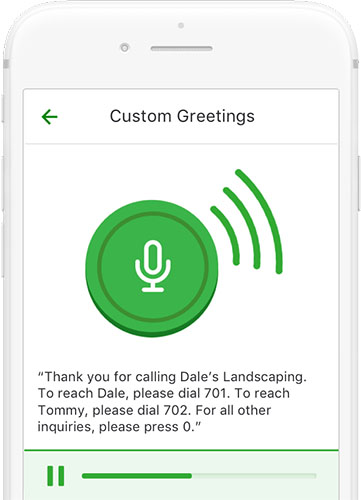
Welcome callers with professional phone greetings. (Source: Grasshopper)
How to Choose the Right Provider for Your Business Type & Needs
When choosing the best RingCentral alternative for your business, evaluating your specific needs and the features each provider offers is essential. Crucial points to consider include your industry, growth projection, team size, operational needs, and budget. Different solutions may be better suited for your communication needs. Below are the key factors to keep in mind when making your decision:
- Team size and growth: Consider the size of your present team and where you forecast your size to be in the short to medium term, at the very least. For example, an expanding startup such as healthcare will want a scalable solution with advanced features like call routing and group messaging for seamless coordination across departments.
- Available features: Carefully evaluate subscription options and identify which solution offers what you need. For instance, a healthcare provider will need secure, Health Insurance Portability and Accountability Act (HIPAA)-compliant videoconferencing and call management for patient interactions. At the same time, remote teams can benefit from robust video and messaging tools to stay connected.
- User-friendliness and experience: Small businesses with limited technology know-how or teams with minimal tech background are better off with a solution that comes with an intuitive interface and strong customer support. Your phone system provider must be easy to set up and responsive. If you have a remote team, evaluate their app because it’s crucial to have an application that allows quick troubleshooting and access to support.
- Cost and value: Regardless of your company size, affordability and flexibility are key, so choosing a provider with low-cost plans and essential VoIP features may be the route. Ensure there’s a difference between cost and features to gain a feature-rich platform without overpaying.
How We Evaluated the Best RingCentral Alternative
To objectively identify the best RingCentral alternatives for this buyer’s guide, I drafted a scoring rubric with the following factors: affordability, robustness of unified communications features, ease of use, and customer service. Each vendor’s value for money and level of popularity were also part of the evaluation.
Learn the details of my assessment by clicking on the tabs below:
20% of Overall Score
To see if VoIP solutions are budget-friendly for small businesses, I checked the cost of entry-level subscription plans. I gave higher points to providers offering rates less than $30 per user, monthly, free plans, and free trials or demos. I likewise favored those with annual and volume discounts and minimal to no termination fees or added charges.
25% of Overall Score
The general features I looked at were tools for handling phone calls: unlimited domestic calling within the US and Canada, robust call management tools, and business messaging. I checked each vendor’s call recording and visual voicemail inclusions because these are crucial for small teams that cannot answer every call.
20% of Overall Score
The advanced features I considered were unified communications tools, namely videoconferencing and team chat, and automation and AI capabilities. I also noted each solution’s analytics and reporting tools and gave higher points if robust integrations exist.
10% of Overall Score
I determined the ease of use by considering the learning curve when setting up and navigating the system. I assigned more points to those with a modern, intuitive interface.
10% of Overall Score
Small businesses without in-house information technology (IT) departments rely on third-party providers to assist with technical concerns. Thus, I checked the available customer support channels and whether the vendor offers 24/7 service.
15% of Overall Score
My expert score includes assessing the provider’s value for money, unique features, and ease of use. I also examined reviews on third-party websites to evaluate their popularity among business professionals.
Frequently Asked Questions (FAQs)
Yes. Ooma is a free alternative to RingCentral, with no monthly charges, only a one-time $99.99 fee for the ATA to enable internet-based calls. However, it offers limited call management features, so if you need advanced functionalities like those on RingCentral, consider a paid but affordable RingCentral alternative such as Zoom Phone, starting at just $10 per user monthly.
Yes. RingCentral uses various security measures to ensure secure communications across all channels. These include network security, toll fraud protection, penetration testing, data encryption, and incident response. Visit the RingCentral Trust Center to learn more about its security policy controls across all RingCentral platforms.
While RingCentral offers full communication features, smaller companies with limited budgets find their subscription packages too pricey. All plans have a strict cap on business SMS, and features like auto-call recording, internet faxing, and business analytics won’t be available without an upgrade. These capabilities do come with other VoIP providers.
Bottom Line
RingCentral is an all-in-one solution for managing calls and collaboration, but its higher pricing and lack of unlimited messaging may only suit some small businesses. Nextiva topped our list of the best RingCentral alternatives because it offers similar VoIP features like videoconferencing, team messaging, call analytics, and a user-friendly mobile app. It’s ideal for small businesses seeking digital communication tools. Contact their sales team for a demo to see if it fits your business well.